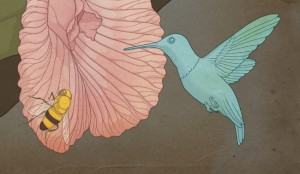The Birds and the Bees and Children’s Literature
 When my children were younger we spent a lot of time at our local public library. We went to the weekly story time and the annual fairs, joined the summer reading programs to win prizes for books read, and spent a lot of time sitting on rugs and tiny chairs reading, reading, and reading.
When my children were younger we spent a lot of time at our local public library. We went to the weekly story time and the annual fairs, joined the summer reading programs to win prizes for books read, and spent a lot of time sitting on rugs and tiny chairs reading, reading, and reading.
It’s a pretty common policy that children’s libraries allow children to checkout an unlimited number of books. We had a rule in our family that you could check out the number of books that coincided with your age. When you were three you got to take home three books, and so on. This made everyone excited for their next birthday when they were allowed to check out one more book!
It also made it easy for me to be sure that each week we returned the correct number of books. I would simply add up the children’s ages and make sure we had that many books in our library basket. When they reached a certain age, our family policy shifted to “you can check out as many books as you can carry.” Often the tower of books came just below their eyes so they could barely see to walk.
Back when we were spending those hours at the library, I rarely had to scrutinize the books they checked out. But today there is a new genre of books written to young children on the topic of assisted reproductive technologies. Books like An Itsy Bitsy Gift of Life: An Egg Donor Story and The Pea that was Me: An Egg Donation Story and many more new books that address egg donation and surrogacy and the whole range of modern family arrangements. For example, there is a growing lists of books about ‘me and my two mommies/daddies’ as well as books that address same-sex parenting such as What Makes a Baby, which is a book that is “truly inclusive” as it addresses a transgender man who conceived with a woman using donor sperm.
If I were a young mother today, I’d think twice before having my children select these books to bring home for story time. Not because I’m a prude and don’t want my children to learn about how babies are made, but because of what I know to be true about third-party conception in particular and assisted reproductive technologies more broadly. These facts are not part of these warm and fuzzy children’s books about the new modern ways families are made (and should not be due to age inappropriateness).
It’s funny, reading the blurbs on several of these books, how much they mirror the advertising and hype that accompanies reproductive technologies marketed to adults. They talk about, “the good lady” and the “generous” egg donor. They use language about giving the gift of life and about how so many people came together to make the baby—it takes a village.
The truth is, though, the children reading these books about themselves or their friends will grow up. Perhaps they will question this delivered narrative, like some adoptees do, and will want to know who, exactly, that good lady was, who it is that looks like them and who maybe has similar interests and talents. They will learn about other people like them who are organizing and speaking out with their stories. They may even stumble upon our films and hear Maggie’s story, or find our writings on what is wrong with egg donation and third party conception.
They may, in fact, grow up to write new children’s books that will tell the other side of the story of how babies should not be made.
Reprinted with permission from the Center for Bioethics and Culture.

